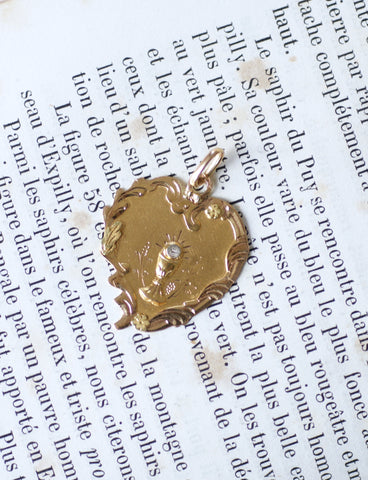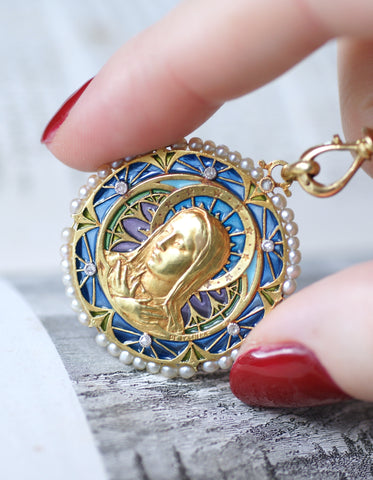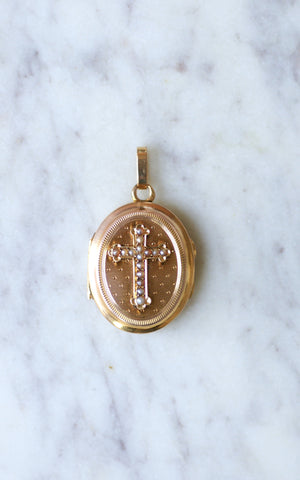Beyond their ornamental quality, jewellery allows people to signify their belonging to a social, cultural or religious group.

Gold and rose-cut diamond cross
The place of religious jewelry within the Church
From the 13th century onwards, religion, along with love, was one of the two main themes of jewellery. The Church had an ambivalent relationship with goldsmithing: it was one of its first customers, along with the dignitaries of power (you only have to look at the objects intended for the liturgy, the pectoral crosses or the episcopal rings to be convinced of this - we talk about those of the bishops in our article on theamethyst); but it also condemns adornment. Piety would in fact be synonymous with austerity: it would be a matter of being content with the beauty that God has given us.

Michelangelo, The Creation of Adam [Detail], 1508-1512, Rome, Sistine Chapel.
The life of a Catholic is marked by several major stages, called the 7 sacraments. The most common ceremonies are still today: baptism, then the Eucharist also called "communion", confirmation and eventually marriage.
In France, there were two major periods in the expansion of the Christian religion: firstly, in the Middle Ages (8th century) with the advent of the Carolingian dynasty, which led to massive Christianisation, and much later, in the 19th century. During this period, France experienced a loss of enthusiasm for religion, initiated by the Enlightenment (18th century) which proposed to counteract the obscurantism of the Catholic Church and accelerated by the revolution of 1789. In the 19th century, the Church decided to re-Christianise France and to do so, it sent its men on mission to the towns and countryside to preach the Gospels. Medals and blessed crosses were then massively distributed to the common people.

Antique chalice medal on rose gold
The tradition of holy medals appeared in the 14th century. It derives from an ancient papal custom of minting circular coins decorated with the Easter lamb at the beginning of a pontificate and then every seven years at Easter. It was not until the 16th century that the Church recognised the cult of the saints at the Council of Trent and that baptismal medals appeared in the image of certain sacred figures as we know them today.

Antique medal in gold, Virgin Mary, and enamel plique-up to date
Baptism symbolises the entry into the Christian life, the child becomes metaphorically God's. On this occasion, the child receives many gifts. For example, we talk about the tradition of giving a spoon in our article on precious and non-precious metals. A branch of coral mounted on silver was also a popular gift in the 15th century. It seems that the belief in the prophylactic qualities of the jewel or its materials developed early on. The Church was forced to approve of coral as the tradition continued at least until the 1900s, when a rosary of red coral in a white leather egg was a common offering for newborns. We refer you to our article on coral to learn all about its virtues!
The cult of the Virgin Mary

Anonymous, 19th century, property of the Carmelite Convent Scalzi.
Let us return to our medals and the devotion around the saints. The cult of the Virgin Mary, which is at the top of the scale, has a specific name: it is called hyperdulia. It was originally a popular movement that the Church was slow to recognise. How can we explain this adoration that many believers devote to Mary?
Alain Houziaux, a doctor of theology and philosophy and a Protestant pastor, puts forward a theory according to which the lack of feminine images in the Christian Trinity could explain the development of Marian theology. Christianity was built on three masculine figures (the Father, the Son and the Holy Spirit), so the Virgin was considered a heavenly figure from the very beginning.
Speaking of the Holy Spirit, do you know the jewel of the same name? We'll show you!

Holy Spirit pendant, gold and enamel
A jewel of faith, a symbol of love and peace, it is a regional pendant that appeared in the 17th century but was democratised in the 19th century. It depicts a stylised dove descending to Earth representing the Holy Spirit and has three pendants symbolising the tears of Christ. Traditionally given as a wedding gift, it was common to add an extra stone for each birth within the couple.
But let us return to Mary, who is said to possess, among other things, the ability to intercede with her Son on behalf of Catholics. She is also, as the mother of the Child Jesus, a clear symbol of maternal love and protection, and is therefore a choice image for the decoration of baptismal medals.

Raphael, The Virgin in the Meadow, 1505-1506, Vienna, Kunsthistorisches Museum.
In addition, in parallel with the evangelisation campaigns of the 19th century, "Marian apparitions" multiplied, i.e. supernatural phenomena resulting in a vision of the Virgin. She appeared "in person" in various places. This is a very serious subject, since these apparitions have economic consequences: construction of religious buildings, development of tourism in these places of pilgrimage (think of Lourdes, for example!) and, as far as we are concerned, the market for pious jewellery.

Ancient Virgin Mary Medal in pink gold
The Church recognises a total of 18 Marian apparitions. Among them, the one in the Rue du Bac in Paris in 1830, which gave rise to a new representation of Mary called the Miraculous Virgin and showing her standing, haloed, with her arms slightly raised from her body as a sign of openness. Exactly like our model above!
We have a second medal which also bears witness to a Marian apparition: the one featuring the icon of Our Lady of Kazan revered by the Orthodox Church. After the 1579 fire in Kazan, a city in western Russia, a nine-year-old girl named Matrona Onuchina had a vision of the Mother of God showing her a place in the city to dig for her icon.

French Edwardian gold Mother of God of Kazan icon pendant locket, rose cut diamonds
This one depicts the Madonna and Child, an old-fashioned theme in the history of art, depicting Mary with a baby Jesus on her lap. Our pendant, surrounded by diamonds, takes up this popular iconography.
Last but not least, one of the most common effigies features the Vierge Auréolée, i.e. Mary in profile nimbed in a holy crown. Below is a model from the 1900s in gold and fine pearls. Discover our complete selection of Vierges Auréolées in the drop-down menu on the right, or at the end of the article for the mobile version.

Ancient Virgin Mary Medal in gold and pearls
virgin mother-of-pearl medal, virgin ray medal
Catholic jewelry from the Middle Ages to the present day
As mentioned above, the medieval period is inseparable from the Catholic Church, and for our purposes, from religious jewellery. Few material testimonies of this period have come down to us. On the one hand, the preservation of heritage is a fairly recent notion, and on the other hand, goldsmith's and silversmith's work was willingly sent to be melted down to support the war effort. Not to mention the wars of religion and their targeted destruction, as well as the transformation of jewellery back to the taste of the day.
Fortunately for us, some have escaped destruction! For example, this early 18th century cross from southern Europe, made of gold and garnets.

Antique 18Kt gold and garnet cross, early 18th century
If it is a religious piece of jewellery, the Catholic cross we wish to focus on is called a Latin cross. Unlike the Greek cross, which has four equal branches, the Latin cross has one end longer than the others. Also called a crucifix, it is a direct reference to the Crucifixion of Jesus. It marks Christ's sacrifice, his love for mankind and finally symbolises hope.

Giotto, The Crucifixion, 1303-1305, Padua, Scrovegni Chapel.
The Jeannette cross is a beautiful example of a Latin cross ornament. Do you know this regional jewel? It can be recognised by the particular geometric shape of its arm ends - oval or diamond. We are not completely sure of the origin of this motif, but it may have been popularised by a theatre actress, Miss Bisson, called "Jeannette" in a play by and starring Jérôme Pointu performed in 1781. For the occasion, the actress would have adorned herself with a cross suspended from her neck by a ribbon. However, according to L'Observateur des Modes of 1826, the tradition of Jeannette crosses is older and their name comes from the fact that they were given or bought on the occasion of St John's Day.

Early 19th Century Rare And Antique French Jeannette Cross in 18Kt Rose Gold
Worn mainly by women in the countryside, city women took hold of the model at the end of the 19th century before abandoning it - a bit like they did with clogs in the 1970s, which have since come back to the forefront.
Finally, the cross is a timeless motif that crosses through the ages, taking on the characteristics of each period. For example, this Art Nouveau jewel, a period rich in naturalist inspiration, features an interlacing of brambles, reminiscent of the crown of thorns of Christ. organic materials This jewel, for example, presents an interlacing of brambles, reminiscent of the crown of thorns of Christ.

Gold and Horn Art Nouveau Cross Pendant, Circa 1910
In fact, over time, fashion has reappropriated the cross, distancing it from its religious symbolism. Today, it is not strange to see an atheist adorned with jewellery in the shape of a cross. Moreover, it is not an ornament but a symbol of faith for Christians. It seems that religious symbols (medals, crosses) are often worn by their holders under their clothes and not on top. Perhaps also because France is a secular country?

Claudia Schiffer for Vogue, 1992.
In any case, crosses have become more decorative than avatars of Catholicism, and everyone can now give them a personal meaning. It would be interesting to look into the reappropriation of the motif by certain subcultures, such as rock icons. Can you imagine, for example, this medallion around Lou Doillon's neck? Or yours, of course! We won't repeat the article on mourning jewellery, but if you're interested in the subject, have a look at Queen Victoria's jewellery.

Antique religious gold and pearls medallion pendanterles
We are well aware that we haven't covered the whole subject of religious jewellery, or even Christian jewellery, but there is so much more to say! And the articles are also an opportunity to present our lovingly sourced collections.
Please note that Galerie Pénélope does not claim any religious affiliation - if you are more into oriental philosophy, our Rose quartz Buddha is for you.
The only religion one would want to subscribe to? The worship of jewellery, of course!
